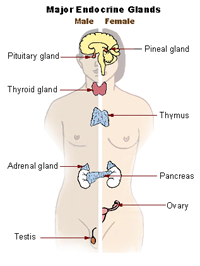 The male and female endocrine systems containing the gonads (testes and ovaries), the pituitary, adrenal and other glands
Testosterone is one of a type of chemical substances within the body known as a hormone. A hormone is a substance that can have effects far beyond its site of release since it is able to travel in the blood stream and therefore to act on various organs. The site of release of testosterone in males is Leydig cells, found in the testes. In women the ovaries produce a small amount of this hormone and, in both sexes, tiny amounts are also released by the adrenal gland.
The male and female endocrine systems containing the gonads (testes and ovaries), the pituitary, adrenal and other glands
Testosterone is one of a type of chemical substances within the body known as a hormone. A hormone is a substance that can have effects far beyond its site of release since it is able to travel in the blood stream and therefore to act on various organs. The site of release of testosterone in males is Leydig cells, found in the testes. In women the ovaries produce a small amount of this hormone and, in both sexes, tiny amounts are also released by the adrenal gland.
Testosterone release is regulated by the HPA axis (hypothalamic pituitary adrenal axis). This axis is a group of structures with interconnections between them. It includes the hypothalamus, found in the brain, the pituitary gland found at the base of the brain, and the adrenal gland found on top of the kidneys. To stimulate testosterone release the hypothalamus releases a substance called gonadotropin releasing hormone. This hormone signals to the pituitary gland to release follicle stimulating hormone and luteinising hormone. The luteinising hormone then triggers the secretion of testosterone by the gonads (i.e. the testes and ovaries) and testosterone is released into the bloodstream. You may have come across the term ‘endocrine system’ which is a collective term for all of the hormone producing regions in the body including the structures in the HPA axis, the gonads and other structures such as the thymus, thyroid and pancreas.
In males large amounts of testosterone are released at two key developmental stages. The first is in the 7th week of fetal development which initiates the process of male genital development. But there is another surge of testosterone during puberty at around the age of 12 years. Testosterone levels are therefore associated with the development of male physical characteristics such as greater amounts of body hair, having a deep voice, and a larger body size with a greater muscle mass. But it is important to recognise that testosterone levels are also associated with male psychological characteristics such as dominant, aggressive and risk taking behaviour.
Research has shown that testosterone has particular effects within the brain where it can alter the reactivity of areas of the brain that use the neurotransmitter dopamine for neuronal communication. What does this mean? Neurons (a type of brain cell) use chemical substances called ‘neurotransmitters’ to communicate with one another across the gaps that exist between them. The release of neurotransmitter by a neuron is therefore a form of neuron to neuron signalling. Dopamine is an important brain substance for behaviour. For example, it has been described as ‘the pleasure chemical’ because dopamine release by neurons in a part of the brain called the ventral tegmental area has been shown to underlie all forms of pleasure motivated behaviour. That is; things like sex, eating (chocolate for example), drinking (alcohol for example) but also other addictive behaviours such as smoking and even financial addictions like gambling. In essence when a person is driven to engage in all of these behaviours there will be dopamine signalling by neurons that form the part of the brain known as the ventral tegmental area.
 Gambling like other addictive behaviours is mediated by the activity of the dopamine system in the brain
Testosterone is therefore likely to achieve its effects on risk taking behaviour because it affects the level of dopamine activity arising from neurons in the ventral tegmental area. For example, larger amounts of testosterone are associated with having more dopamine neurons, and more dopamine neurons could mean more dopamine will be released by ventral tegmental area neurons. It has, for example, also been shown that individuals who seem to display a greater level of risk taking behaviour have less of a certain type of dopamine receptor. A receptor is a protein made by a cell that will bind to neurotransmitter. Usually receptors are involved in binding neurotransmitter from other neurons so that neurons can talk to one another. But sometimes special receptors are made by cells called autoreceptors. Autoreceptors are made by the neuron that releases the neurotransmitter meaning that this cell is producing its own feedback mechanism. In this case when dopamine is released it binds to the autoreceptors and has the effect of dampening down the level of release of dopamine from that cell – a kind of inhibitory feedback. Now imagine what would happen if a person had less of these dopamine autoreceptors. In this case the person could experience a continued unchecked release of dopamine when engaging in certain behaviours. The result is suggested to be an individual who is more likely to be impulsive, driven to satisfy their urges and to seek out a ‘thrill’ in life. Such individuals are said to be ‘sensation seekers’ by psychologists. It has also been found that such individuals are more prone to developing addiction. There are other types of dopamine receptor that have also been associated with testosterone levels and risk taking so there is more to the dopamine story than can be explained here but for now this gives some idea of how testosterone might affect risk taking behaviour.
Gambling like other addictive behaviours is mediated by the activity of the dopamine system in the brain
Testosterone is therefore likely to achieve its effects on risk taking behaviour because it affects the level of dopamine activity arising from neurons in the ventral tegmental area. For example, larger amounts of testosterone are associated with having more dopamine neurons, and more dopamine neurons could mean more dopamine will be released by ventral tegmental area neurons. It has, for example, also been shown that individuals who seem to display a greater level of risk taking behaviour have less of a certain type of dopamine receptor. A receptor is a protein made by a cell that will bind to neurotransmitter. Usually receptors are involved in binding neurotransmitter from other neurons so that neurons can talk to one another. But sometimes special receptors are made by cells called autoreceptors. Autoreceptors are made by the neuron that releases the neurotransmitter meaning that this cell is producing its own feedback mechanism. In this case when dopamine is released it binds to the autoreceptors and has the effect of dampening down the level of release of dopamine from that cell – a kind of inhibitory feedback. Now imagine what would happen if a person had less of these dopamine autoreceptors. In this case the person could experience a continued unchecked release of dopamine when engaging in certain behaviours. The result is suggested to be an individual who is more likely to be impulsive, driven to satisfy their urges and to seek out a ‘thrill’ in life. Such individuals are said to be ‘sensation seekers’ by psychologists. It has also been found that such individuals are more prone to developing addiction. There are other types of dopamine receptor that have also been associated with testosterone levels and risk taking so there is more to the dopamine story than can be explained here but for now this gives some idea of how testosterone might affect risk taking behaviour.
If you are interested in learning more about risk taking behaviour, dopamine and addictions why not try our second level module SDK228 The science of the mind: investigating mental health. This module covers addiction as one of its topics with a focus on the role of dopamine in producing risk taking behaviour. The module also covers other aspects of mental health including mood disorders like depression and anxiety, as well as dementias. SDK228 is part of our degree in Health Sciences (Q71) and our degree in Natural Sciences (Q64), as well as our Open Degree.

Rate and Review
Rate this article
Review this article
Log into OpenLearn to leave reviews and join in the conversation.
Article reviews